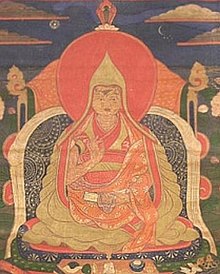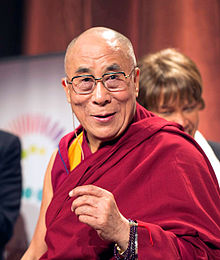The Dalai Lama
| Dalai Lama | |
|---|---|

|
|
| Reign | 1391–1474 |
| Tibetan | ཏཱ་ལའི་བླ་མ་ |
| Wylie transliteration | tā la'i bla ma |
| Pronunciation | [táːlɛː láma] |
| Conventional Romanisation | Dalai Lama |
| House | Dalai Lama |
| Dynasty | Gelug |
| Tenzin | |
|---|---|
| The 14th Dalai Lama | |
 |
|
| Reign | November 17, 1950 – present |
| Predecessor | 13th Dalai Lama |
| Prime Ministers | |
| Tibetan | བསྟན་འཛིན་རྒྱ་མཚོ་ |
| Wylie | bstan 'dzin rgya mtsho |
| Pronunciation | [tɛ̃ ́tsĩ càtsʰo] |
| Transcription (PRC) |
Dainzin Gyaco |
| THDL | Tenzin Gyatso |
| Chinese | |
| Pinyin | Dānzēng Jiācuò |
| Father | Choekyong Tsering |
| Mother | Diki Tsering |
| Born |
6 July 1935 Taktser, Qinghai |
| Signature |  |
The Dalai Lama /ˈdɑːlaɪ ˈlɑːmə/ (US), /ˌdælaɪ ˈlɑːmə/ (UK) is a monk of the Gelug or "Yellow Hat" school of Tibetan Buddhism, the newest of the schools of Tibetan Buddhism founded by Je Tsongkhapa. The 14th and current Dalai Lama is Tenzin Gyatso.
The Dalai Lama was an important figure of the Geiuk tradition. Although finding dominance in Central Tibet, The Dalai Lama was an important figure beyond sectarian boundaries. The Dalai Lama figure was important for many reasons. He was a symbol of unification of the state of Tibet, where he represented Buddhist values and traditions.
The Dalai Lama is considered to be the successor in a line of tulkus who are believed to be incarnations of Avalokiteśvara, the Bodhisattva of Compassion, called Chenrezig in Tibetan. The name is a combination of the Mongolic word dalai meaning "ocean" (coming from Mongolian title Dalaiyin qan or Dalaiin khan, translated as 'Gyatso' in Tibetan) and the Tibetan word བླ་མ་ (bla-ma) meaning "guru, teacher, mentor". The Tibetan word "lama" corresponds to the better known Sanskrit word "guru".
...
Wikipedia
